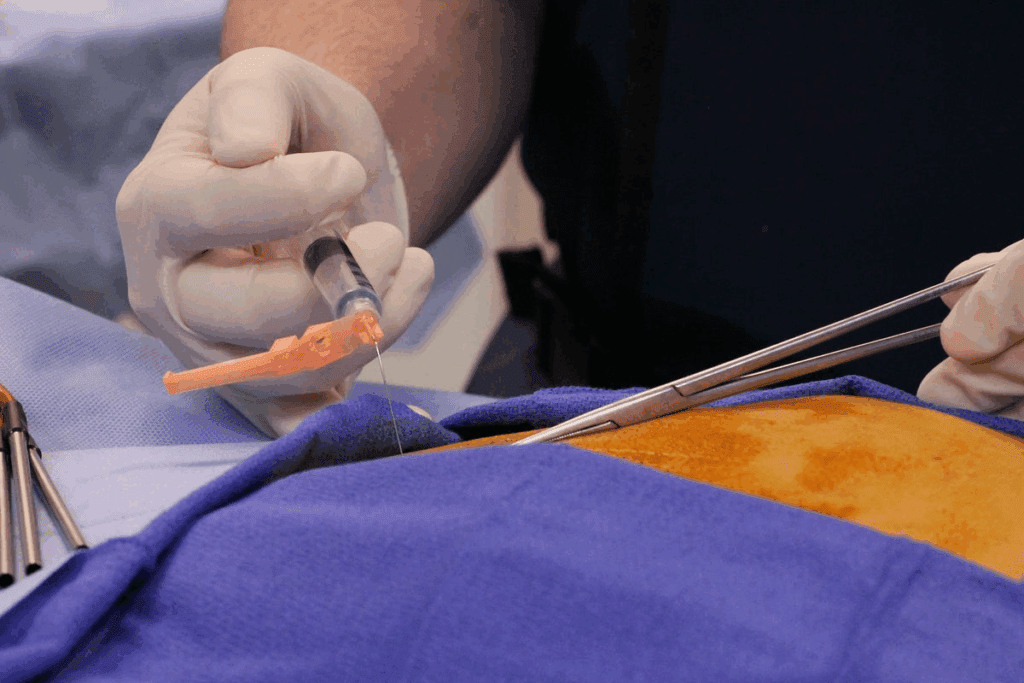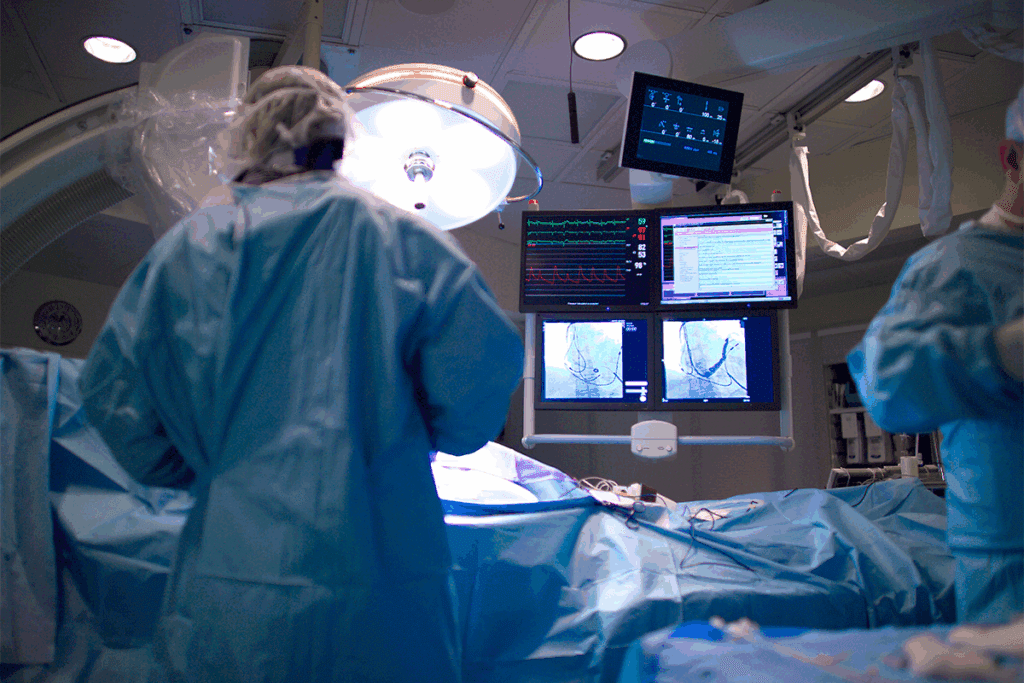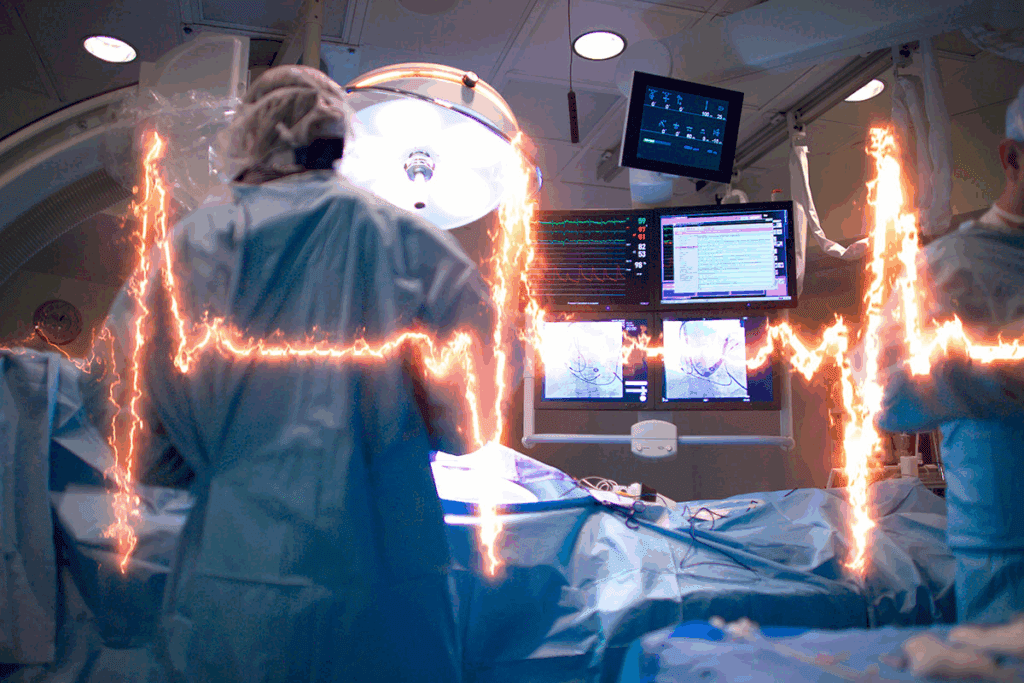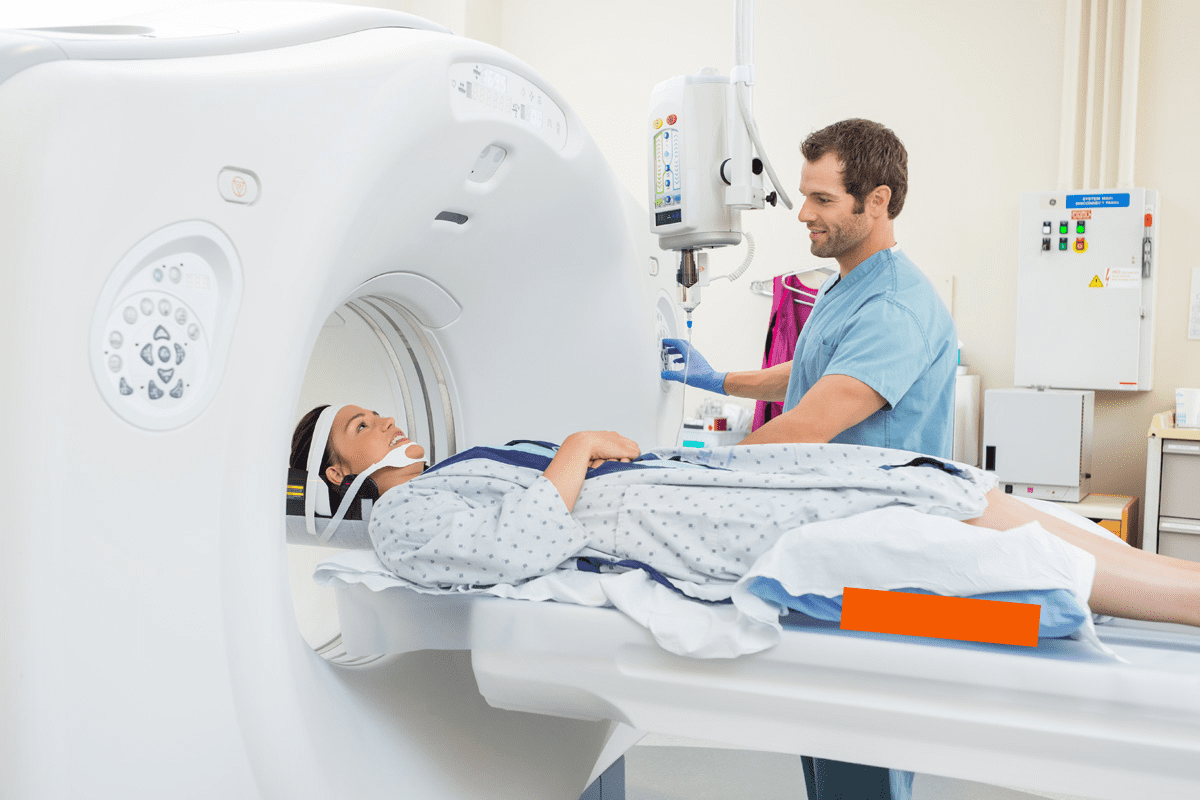Last Updated on November 26, 2025 by Bilal Hasdemir

At Liv Hospital, we focus on advanced pain relief and non-invasive treatments. Radiofrequency ablation (RFA) is a procedure that’s getting a lot of attention. It’s known for its success in treating many medical issues. Many patients also ask about the RFA medical abbreviation, which stands for Radiofrequency Ablation — a technique that uses heat generated by radio waves to target and reduce pain or abnormal tissue.
Radiofrequency ablation uses electrical energy to heat up tissue, killing cells. It helps with chronic pain, some cancers, and heart rhythm problems. Knowing what RFA stands for and how it works helps patients choose the right treatment.
We employ the newest radiofrequency ablation techniques for care that’s both personal and ethical. Our team is committed to guiding patients through their treatment choices. We aim to help them get the best results possible.
Key Takeaways
- Radiofrequency ablation (RFA) is a minimally invasive procedure.
- RFA uses electrical energy to heat up tissue, causing cell death.
- It’s used to treat chronic pain, certain cancers, and cardiac arrhythmias.
- Understanding RFA can help patients make informed decisions about their treatment.
- Liv Hospital uses the latest RFA techniques for personalized care.
Understanding the RFA Medical Abbreviation

RFA stands for Radiofrequency Ablation, a method used in medicine. It uses radiofrequency energy to treat different health issues. This method is popular because it’s less invasive and works well.
Origin and Definition of RFA in Medical Context
Radiofrequency Ablation (RFA) is a medical treatment that uses electrical energy to heat and kill cells. The origin of RFA is in its precise tissue ablation with little damage to nearby areas. It’s guided by imaging tests like ultrasound, CT, or MRI for accurate energy application.
The term “ablation” means removing or destroying tissue. In RFA, it’s done by applying radiofrequency energy. This energy is sent through a special electrode, placed near the target tissue under imaging.
Basic Principles of Radiofrequency Energy in Medicine
The basic principle of radiofrequency energy in medicine is its ability to heat tissues. When radiofrequency waves hit the body, they make ions in the tissue vibrate. This creates heat, allowing for the precise removal of targeted tissues.
Radiofrequency energy is used for more than just ablation. It’s also used for tissue coagulation and helping with some diagnostic procedures. Its versatility makes it a key tool in medicine.
The Science Behind Radiofrequency Ablation

Radiofrequency ablation treatment uses radiofrequency energy to destroy diseased tissue. This method is based on the idea that radiofrequency energy can create heat in the body. This heat is used to achieve the desired therapeutic effect.
How Radiofrequency Energy Creates Controlled Heat
When radiofrequency energy is applied to tissue, it generates heat. This happens because the tissue resists the electrical current. The heat is carefully controlled to stay within a therapeutic range. This range is between 50°C to 100°C, which is enough to destroy diseased tissue without harming healthy tissue too much.
A specialized electrode is used in this process. It is inserted into the target tissue under imaging guidance. The electrode then emits radiofrequency energy, heating the surrounding tissue. This precision allows for treating specific areas without damaging too much tissue.
Mechanism of Tissue Ablation and Preservation
The way radiofrequency ablation works is by denaturing proteins and disrupting cellular membranes. This leads to cell death. The process is localized to the area around the electrode, protecting the surrounding tissue and reducing complications.
A key benefit of RFA is its ability to preserve the treated area’s structure. For example, in treating tumors, RFA can kill cancer cells while keeping the surrounding tissue intact. This helps reduce complications and speeds up recovery.
| Aspect | Description | Benefit |
| Tissue Heating | Radiofrequency energy heats tissue to therapeutic temperatures. | Ablation of diseased tissue. |
| Precision | Electrode placement under imaging guidance. | Targeted treatment with minimal damage to surrounding tissue. |
| Tissue Preservation | Localized treatment preserving structural integrity. | Reduced risk of complications and faster recovery. |
Radiofrequency ablation treatment is a minimally invasive solution for many medical conditions. It’s used for chronic pain management and cancer treatment. Understanding the science behind RFA helps healthcare providers use it to improve patient outcomes.
Medical Applications of Radiofrequency Ablation
RFA is used in many ways, from treating pain to fighting cancer. It’s a key tool in modern medicine, a less invasive option than surgery.
RFA for Chronic Pain Management
RFA helps manage chronic pain, like back and joint pain. It creates a thermal lesion to block pain signals to the brain. This offers relief for those who haven’t found help elsewhere.
Many patients see a big drop in pain after RFA. It’s great for those with facet or sacroiliac joint pain, which can really hurt your daily life.
Cancer Treatment Applications
RFA treats some cancers, like tumors that are hard to reach surgically. It uses heat to kill cancer cells while keeping healthy tissue safe.
We’ve used RFA on liver, kidney, and lung tumors. Its precision is key for tumors near important areas, where surgery is too risky.
Cardiac Arrhythmia Treatment with RFA
In cardiology, RFA is key to treating heart rhythm problems. It ablates abnormal heart pathways, fixing the rhythm. It’s great for atrial fibrillation and supraventricular tachycardia.
We target the heart areas causing arrhythmia with RFA. Its minimally invasive nature makes it a top choice for many.
Other Medical Uses for RFA
RFA is also used for varicose veins, benign prostatic hyperplasia, and more. Its ability to treat specific areas with little disruption is its strength.
As tech improves, we’re finding new uses for RFA. It’s helping patients in many medical fields.
Types of RFA Procedures
RFA is used in many medical fields to help treat different health problems. It shows how this technology can help with a wide range of issues.
Spinal and Joint RFA for Pain Relief
RFA is often used to manage chronic pain, focusing on the spine and joints. Spinal RFA uses radiofrequency energy to stop pain signals from the facet joints. It helps those with chronic lower back pain who haven’t found relief with other treatments.
Joint RFA treats pain in other joints, like the sacroiliac joint or knee. It targets the pain-causing nerves, giving relief to those with chronic joint pain.
Tumor and Cancer RFA Techniques
RFA is also used to treat some tumors and cancers. Tumor RFA uses a needle electrode to heat and kill tumor cells under imaging guidance.
Cancer RFA is used for liver tumors and others in the kidney, lung, and bone. It’s a good option for those who can’t have surgery or have tried other treatments without success.
RFA operations involve needles or catheters guided by imaging, often done under local anesthesia. Its precision and effectiveness make it a key treatment for many conditions, from chronic pain to cancer.
The RFA Procedure: What to Expect
Exploring the RFA procedure, it’s key to know the steps and what patients can expect. The process includes preparation, the operation, and recovery. Each stage is important for a successful outcome.
Pre-Procedure Preparation and Evaluation
Before an RFA procedure, patients get a detailed evaluation. This checks if they’re right for the treatment. It looks at their medical history, current meds, and might include tests.
We also give specific instructions to follow. This could mean fasting or avoiding certain meds. It’s to keep risks low during the procedure.
Preparation is key to successful RFA. Our team talks with patients about what to expect. We discuss the benefits and risks of RFA.
During the RFA Operation
During the RFA, patients get local anesthesia. This numbs the area where the procedure happens. We use imaging, like ultrasound or CT scans, to guide the needle or catheter.
The needle or catheter goes through the skin to the target area. Then, the RFA device sends radiofrequency energy. This creates heat that destroys the targeted tissue.
It’s a precise process that needs skilled professionals. Patients might be awake but are usually comfortable due to the anesthesia.
Post-Procedure Recovery and Care
After the RFA, patients are watched for any immediate issues. We give them care instructions. This includes managing pain, following activity limits, and watching for signs.
Most patients can go back to normal activities in a few days. But full recovery might take longer.
Post-procedure care is key to the best recovery. Our team is here to answer questions and support during recovery.
Equipment and Technology Used in RFA Procedures
RFA procedures rely on advanced equipment for precision. We use the latest technology to ensure accuracy and safety during treatments.
Imaging Guidance Systems
Imaging systems are vital for RFA success. Ultrasound, CT, and MRI guide needles or catheters to the target. Real-time imaging helps place and monitor the procedure accurately.
The most used imaging modalities for RFA are:
- Ultrasound
- Computed Tomography (CT)
- Magnetic Resonance Imaging (MRI)
| Imaging Modality | Advantages | Limitations |
| Ultrasound | Real-time imaging, portable, and cost-effective | Operator-dependent, limited depth penetration |
| CT | High-resolution images, good for complex anatomy | Radiation exposure, contrast required |
| MRI | Excellent soft tissue contrast, no radiation | High cost, limited availability, claustrophobia |
Radiofrequency Generators and Electrodes
Radiofrequency generators and electrodes are essential for RFA. The radiofrequency generator creates the energy that goes to the tissue through the electrode.
The electrode type depends on the treatment and tumor size. Monopolar and bipolar electrodes are used, with bipolar being better for some procedures due to its controlled energy delivery.
We’ve covered the main equipment and technology in RFA procedures. They are key to the success and safety of treatments.
Benefits of Radio-Frequency Ablation vs. Traditional Surgery
Radio-Frequency Ablation (RFA) is a minimally invasive procedure. It offers many benefits over traditional surgery. These include shorter recovery times and fewer complications.
Minimally Invasive Advantages
RFA uses small incisions and needle-like probes. These are guided by imaging technologies. This method causes less damage to tissues and speeds up healing.
The reduced trauma to the body leads to less pain after surgery. It also lowers the chance of infection.
“RFA has changed how we treat many medical conditions,” says a leading medical expert. “It treats diseased tissue precisely while keeping healthy tissue safe.”
Recovery Time and Complication Rates
RFA greatly affects recovery time. Patients often have shorter hospital stays and get back to normal faster than those with traditional surgery.
- Reduced risk of complications due to the minimally invasive nature
- Less post-operative pain
- Faster recovery times
- Lower risk of infection
Research shows RFA lowers complication rates compared to open surgery. This is great for patients at high risk for surgery complications or with health issues.
Patient Selection and Effectiveness of Radiofrequency Ablation Treatment
To get the most out of RFA, knowing who is best suited for it is key. This treatment works well for many health issues. But it only works best when the right patients get it.
Ideal Candidates for RFA
People with chronic pain who have pain in one area are often good candidates for RFA. It can really help with pain. Also, those with certain cancers or heart rhythm problems might find RFA helpful.
Before deciding if RFA is right, we look at a lot of things. We check the patient’s health history, do a physical exam, and run tests. We look at how well they’ve done with other treatments, too.
Contraindications and Limitations
Even though RFA is helpful, there are times it’s not right. People with pacemakers or other implants might need special care. Also, those with bleeding problems or infections might not be good candidates.
RFA can help with pain for a year or more for some. But it’s not a fix for the problem itself. We talk about what it can and can’t do to make sure patients know what to expect.
Success Rates and Duration of Results
How well RFA works depends on the patient and the condition. Many people find a lot of relief, sometimes for 12 months or more. How long it lasts can depend on how bad the problem is and how well the treatment goes.
We keep a close eye on our patients after RFA. This helps us see if it’s working and make changes if needed. By picking the right patients and knowing what RFA can and can’t do, we help our patients get the most out of it.
Recent Advancements in RFA Technology and Techniques
Recent years have brought big changes to Radiofrequency Ablation (RFA) technology. These changes have made RFA more effective and safer for many medical uses. We’ve seen a big shift in RFA, with new ideas that have made treatments better and opened up new uses.
Innovations in Equipment and Delivery Methods
New RFA equipment has been key to its success. Advanced radiofrequency generators and precision electrodes help make treatments more precise and effective. For example, bipolar and multipolar RFA systems have made it easier to heat tumors evenly.
Also, better imaging tools like ultrasound and MRI have made RFA procedures more accurate. These tools let doctors watch and adjust the treatment as it happens, leading to better results.
Expanded Applications and Research Directions
RFA’s ability to treat many conditions has led to its wider use. It’s now used not just for pain and cancer, but also for cardiac arrhythmias and varicose veins. Researchers are looking into using RFA for even more diseases, making it even more useful.
Studies are also working on making RFA treatments last longer and work better. They’re looking at how RFA can be used with other treatments to get even better results. As RFA keeps getting better, we can expect to see even more ways it can help patients.
We’re dedicated to keeping up with these advancements. We want our patients to have access to the latest and best treatments. With RFA technology getting better all the time, we’re excited to see what the future holds for patient care.
Conclusion: The Future of RFA in Medicine
Radiofrequency Ablation (RFA) has changed the medical world. It’s clear that RFA’s future in medicine is bright. With ongoing research and new technology, it will get even better.
RFA is always getting better, with new uses and ideas coming up. We’ll see new RFA tools and ways to use them. This will help treat more medical problems.
As RFA keeps improving, patients will get better results faster. They’ll also recover quicker and enjoy a better life. The future of RFA in medicine is exciting. We’re ready to lead in these advancements, ensuring top-notch care for everyone.
FAQ
What does RFA stand for in medicine?
RFA stands for Radiofrequency Ablation. It’s a medical procedure that uses heat to destroy damaged tissues.
What is Radiofrequency Ablation used for?
It treats chronic pain, cancer, and heart rhythm problems. It’s used for many diseases.
How does Radiofrequency Ablation work?
It uses radiofrequency energy to create heat. This heat destroys the targeted area.
What are the benefits of RFA compared to traditional surgery?
RFA is less invasive. It has a shorter recovery time and fewer complications. It also damages less tissue.
What are the different types of RFA procedures?
There are many types. These include spinal and joint treatments for pain, cancer treatments, and heart rhythm treatments.
What is the success rate of RFA treatment?
Success rates vary. But RFA is effective for chronic pain and some cancers.
What are the contraindications for RFA?
Certain conditions, like pacemakers and pregnancy, are contraindications. So are some medical conditions and anatomical limitations.
What is the role of imaging guidance in RFA procedures?
Imaging systems like ultrasound guide RFA. They ensure the electrode is placed correctly for effective treatment.
What are the recent advancements in RFA technology and techniques?
New equipment and methods are being developed. These advancements are expanding RFA’s use in medicine.
How is RFA used in cancer treatment?
RFA destroys tumors and cancer cells. It’s often used with other treatments like chemotherapy or surgery.
What is the recovery process like after an RFA procedure?
Recovery involves monitoring and managing complications. Follow-up appointments check the treatment’s success.
References
- Pagano, L. (2022). Radiofrequency Ablation as an Alternative to Conventional Treatments. Cancer Treatment Reviews. https://pmc.ncbi.nlm.nih.gov/articles/PMC9091301/






